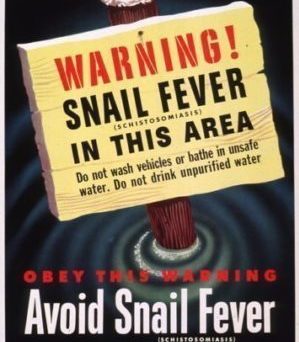
(图像来源:flickr)
血吸虫病的背景
Schistosomiasis,也称为蜗牛发烧或比尔哈齐亚,是由parasitic blood flukesendemic to subtropical and tropical regions. Transmission occurs in 78 countries, with 52 countries having moderate-to-high transmission requiring预防性治疗to reduce and prevent morbidity.2017年,超过2280万人需要预防治疗, with at least 90% living in Africa.
这two major forms of disease are intestinal and urogenital schistosomiasis and these are mainly caused by five血吸虫species. Schistosomiasis primarily affects poor and rural communities where people are regularly exposed to infested water, such as during domestic, occupational and recreational activities.

发生感染时parasite larval forms leave freshwater snails, their intermediate host, and penetrate human skin in infested water。幼虫发展成为生活在雌性释放卵子的血管中的成年血块。鸡蛋通过粪便或尿液排出,并在水中孵化,污染淡水来源并导致向前传播。
一些卵也会产生在身体组织中,导致炎症反应和进行性器官损伤,从而导致死亡。
Schistosomes on permanent vacation?
Both environmental and anthropogenic changes may influence theemergence and spread of infectious diseases worldwide。特别关心的是热带传染病的迁移到更温和的地区。但是,依靠有限分散的宿主(例如蜗牛)的热带疾病似乎较小。
因此,当2014年在法国和德国医院诊断出泌尿生殖血吸虫病病例。
Urogenital schistosomiasis is caused by血吸虫血吸虫病,以及该属的淡水蜗牛Bulinus充当中间主机。确定的大型诊断运动106 cases of urogenital schistosomiasis与科西嘉岛南部的Cavu河上的水接触有关Bulinus截断在场。

New cases of local infections were identified in the summers of 2015 and 2016, suggestingtransmission was ongoing and established in Corsica。这schistosome strain was identified as ahybrid lineage from interbreeding betweenS. haematobiumandS. Bovis(一种与反刍动物相关的黑素物种)。
在温带纬度中,包括:
- Adult parasites survive in their human hosts during winter and transmission persists through annual release of schistosome eggs from infected individuals.
- 当地的蜗牛宿主和感染的血块幼虫在冬季温度下生存,幼虫可以在越冬后完成生命周期。
This 2ndhypothesis was recently investigated in an ecological experiment byMulero及其同事。这researchers aimed to quantify the survival of healthy and infected snails, as well as schistosome strains within their hosts, under winter conditions. They also sought to determine whether schistosomes could complete their life cycle after overwintering.
Snail survival and pre-adaptation of schistosomes to overwinter
作者衡量了不同的生活历史特征BULINUS/SCISTOMASOstrain pairings, including:
- Bulinus(B.T) from tropical and temperate countries (Cameroon, Spain and Corsica) to test for local adaptation in temperate regions.
- TwoS. haematobium(S.H) strains (pureS. haematobium来自喀麦隆或S. haematobium-bovis从科西嘉岛的杂种)测试与冷应激相关的蜗牛和黑斑很好生存的任何寄生虫菌株的影响。
还维持了喀麦隆,科西嘉岛和西班牙的一批非暴露蜗牛。
选择实验温度以反映在Cavu River测得的热动力学。温度实验包括:
- A progressive decrease in temperature over 4 weeks
- A long-term maintenance at specific “winter temperature” for 14 weeks
- A progressive increase in temperature over 3 weeks
- 幼虫脱落摇来摇去m snails checked for a further 4 weeks

One control temperature (24 °C), optimal for snail and schistosome development, and three “winter temperatures” (4, 8 and 16 °C) were tested for each infection. The snails were individually checked for larval shedding after returning to 24 °C, and pooled larvae from theS.H科西嘉人的压力维持在8°C被用来fect hamsters. Adult schistosomes were recovered from their mammal host after 90 days.

欧洲的血吸虫病:下一个分期付款
作者发现地中海B. Truncatus应变(即西班牙,科西嘉岛)可以在长期的寒冷期内生存,并且与热带相比,它们更好地适应冬季条件B. Truncatus(即喀麦隆)。被感染的蜗牛在冷温下的存活率也比在“最佳”温度更高的温度下显示出更高的存活率。
此外,在感染温带蜗牛并在恢复最佳温度后产生后代时,这两种螺旋体菌株均同样幸存下来,无论其保持在最佳温度下。这S.H-bCorsican strain larvae maintained at 8 °C also successfully developed into adult worms within their hamster hosts. These findings signal that schistosomes can overwinter in temperate climates, which may in part account for schistosome establishment and maintenance in Corsica.

Mulero et al have demonstrated that the thermal range of schistosomes is surprisingly broader than that of their local snail hosts. Therefore, the dispersal and establishment of schistosomiasis in temperate regions seems to rely on locally adapted snail host strains, which are currently known to persist in France, Italy, Portugal, Spain and Greece.
这emergence of a tropical snail-borne disease in Corsica was an unexpected finding in 2014, but do these results suggest schistosomiasis could soon be coming to a river near you?

Comments